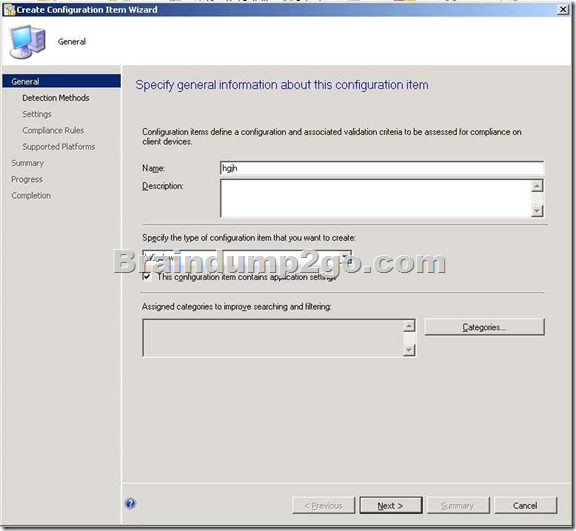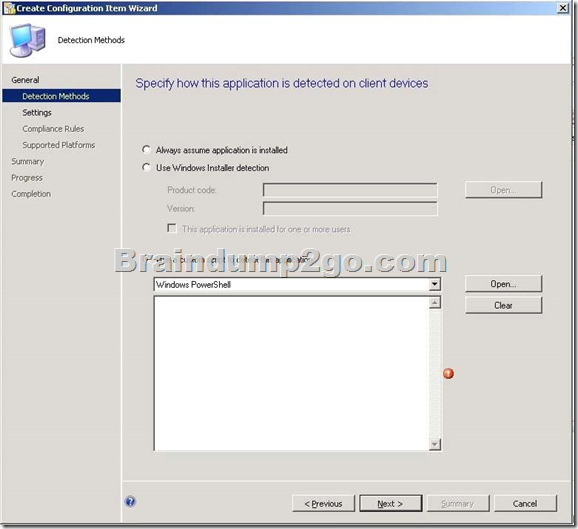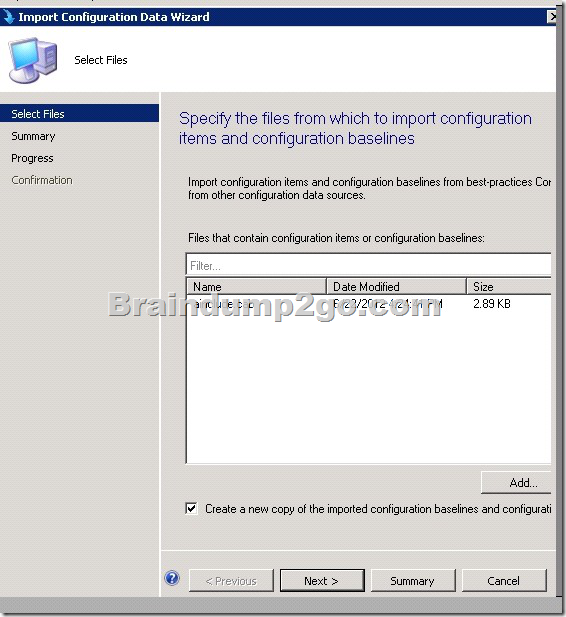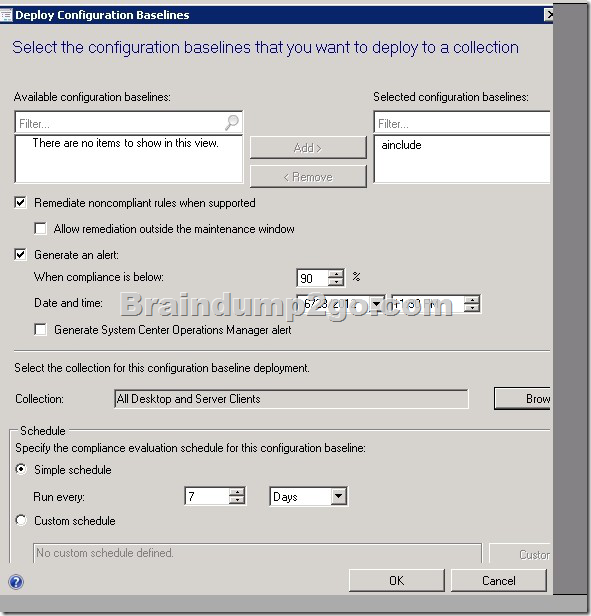Braindump2go New Published Microsoft 70-243 Dumps PDF Contanins the latest questions from Microsoft Exam Center! 100% Certification got guaranteed!
Vendor: Microsoft
Exam Code: 70-243
Exam Name: Administering and Deploying System Center 2012 Configuration Manager
QUESTION 91
You have a System Center 2012 Configuration Manager environment.
You are deploying operating systems and migrating user profiles.
You configure the state migration point to immediately delete profile data.
Migrations are failing for user profiles that are larger than 25 GB.
You need to successfully migrate all user profiles.
What should you do?
A. Increase the retention period on the state migration point deletion policy.
B. Decrease the minimum free space size setting on the state migration point.
C. Remove unnecessary applications from the computers that are being migrated.
D. Increase the hard disk space on the computers that are being migrated.
Answer: B
QUESTION 92
You have a System Center 2012 Configuration Manager environment.
During an operating system deployment to a specific computer, you need to ensure that all user state data is migrated to a new computer.
What should you do?
A. Configure a user state restore task, and configure the task to transfer the data to the new computer.
B. Configure a user state restore task, and select the Customize how user profiles are restored option.
C. Create a computer association, and specify the details for the transfer.
D. Edit the MigSys.xml file that is specified in the user state restore task.
Answer: C
QUESTION 93
You install System Center 2012 Configuration Manager in your Active Directory environment.
You configure a single Configuration Manager site.
You need to enable Network Access Protection in your environment.
You extend the Active Directory schema.
You create the System Management container in Active Directory.
You set permissions on the System Management container for the site server. Which three actions should you perform next?(Each correct answer presents part of the solution. Choose three.)
A. Enable the Network Access Protection client agent.
B. Enable the Software Updates client agent.
C. Configure the Configuration Manager site to publish settings to Active Directory.
D. Configure the Configuration Manager site for native mode.
E. Enable the Desired Configuration Management client agent.
F. Configure a server with the system health validator point and the Network Policy Server role.
Answer: ACF
QUESTION 94
You have a System Center 2012 Configuration Manager environment.
You use System Center Operations Manager 2007 to monitor your Configuration Manager 2007 servers.
You need to generate an alert when a software distribution point fails.
What should you monitor?
A. the ccmexec.log file
B. component status of your distribution points
C. site system status of your distribution points
D. the smsprov.log file
Answer: C
QUESTION 95
You have a System Center 2012 Configuration Manager environment.
When users attempt to install a program by using the Run Advertise program, they receive a message that the desired software is not available.
You need to view the status to find out why software is not available.
What should you do?
A. Connect to the client computers, and view the LocationServices.log file.
B. Connect to the client computers, and view the DataTransferService.log file.
C. Connect to the distribution point, and view the LocationServices.log file.
D. Connect to the distribution point, and view the PatchDownloader.log file.
Answer: A
QUESTION 96
You have a System Center 2012 Configuration Manager environment.
You apply a desired configuration baseline named Baseline1 to all servers in a collection named Coll1.
You need to view Baseline1 configuration results.
What should you do?
A. Create a new Web report based on status message.
B. Create a new Web report based on hardware inventory.
C. Run an Asset Intelligence Web report for Coll1.
D. Run a compliance summary Web report for Coll1.
Answer: D
QUESTION 97
You have a System Center 2012 Configuration Manager environment.
You need to prevent computers in remote offices from installing packages from the distribution point in the main office.
What should you do?
A. Configure the central site system role with protected boundaries.
B. Configure the remote office site system roles with protected boundaries.
C. Configure the central site distribution point as a protected distribution point.
D. Configure the remote office distribution points as protected distribution points.
Answer: A
QUESTION 98
Your network contains a System center 2012 Configuration Manager environment.
The environment contains a reporting services point.
A group of users is responsible for creating custom reports. The custom reports will be published.
You need to identify which tools can be used to create and publish custom reports to Microsoft SQL Server Reporting Services (SSRS).
Which tools should you identify? (Choose all that apply.)
A. Report Builder
B. Microsoft SQL Server Business Intelligence Development Studio
C. Microsoft Access 2010
D. Reporting Services Configuration Manager
E. Microsoft SQL Server Management Studio
Answer: ABD
Explanation:
A: http://technet.microsoft.com/en-us/library/hh213578.aspx
B: http://en.wikipedia.org/wiki/Business_Intelligence_Development_Studio
D: http://technet.microsoft.com/en-us/library/ms156305.aspx
QUESTION 99
Your network contains a System center 2012 Configuration Manager environment.
You are creating a configuration item that contains application settings for Microsoft Office 2010. You need to detect whether Office 2010 is installed before validating the configuration item.
What should you do?
A. Create a report to display all installed software.
B. Enable Use a custom script to detect this application.
C. Create a direct membership collection.
D. Create an automatic deployment rule.
Answer: B
Explanation:
Create Configuration Item Wizard


QUESTION 100
Your network contains a System Center 2012 Configuration Manager environment.
You create a report named Report1. Report1 is used by multiple users. Users report that it takes too long to load Report1.
You need to reduce the amount of time it takes to load Report1.
What should you do?
A. Enable caching for the report.
B. Decrease the Size of the ReportServer database.
C. Decrease the session timeout value for the Reports website.
D. Increase the size of the ReportServerTempDB database.
Answer: A
Explanation:
Report caching can shorten the time it takes for a user to retrieve a report, particularly if the
report is large or accessed frequently. When a report is requested, a query is sent to the database, an intermediate form of the report is cached on the report server, and the final
report is rendered to the end user. Report caching forces the intermediate version of the
report to be cached on the report server and provides a more consistent user experience
with a reduced load on the database.
QUESTION 101
Your network contains a System Center 2012 Configuration Manager environment.
Two weeks ago, you deployed a Windows Installer package named App1.
You need to remediate a registry value that applies only to the client computers that have App1 installed. The solution must minimize network traffic.
What should you do?
A. Modify the App1 Windows Installer package to contain the registry setting, and then create a new
application for Appl.
B. Modify the App1 Windows Installer package to contain the registry setting, and then configure the
existing application for App1 to use the new Windows Installer package.
C. Create an application-based configuration item, configure a rule for an existential type, and then
import the registry setting from a client computer that has App1 installed.
D. Create an application-based configuration item, configure the detection method to use the Windows
Installer product code of App1, and then import the registry setting from a client computer that has
App1 installed.
Answer: D
Explanation:
http://technet.microsoft.com/en-us/library/gg682139.aspx
Introduction to Compliance Settings in Configuration Manager
Compliance settings in System Center 2012 Configuration Manager provides a unified interface and user experience that lets you manage the configuration and compliance of servers, laptops, desktop computers, and mobile devices in your organization. Compliance settings contains tools to help you assess the compliance of users and client devices for many configurations, such as whether the correct Windows operating system versions are installed and configured appropriately, whether all required applications are installed and configured correctly, whether optional applications are configured appropriately, and whether prohibited applications are installed. Additionally, you can check for compliance with software updates, security settings, and mobile devices. Configuration item settings of the type Windows Management Instrumentation (WMI), registry, script, and all mobile device settings in Configuration Manager let you automatically remediate noncompliant settings when they are found.
Compliance is evaluated by defining a configuration baseline that contains the configuration items that you want to evaluate and settings and rules that describe the level of compliance you must have. You can import this configuration data from the web in Microsoft System Center Configuration Manager Configuration Packs as best practices that are defined by Microsoft and other vendors, in Configuration Manager, and that you then import into Configuration Manager. Or, an administrative user can create new configuration items and configuration baselines.
http://technet.microsoft.com/en-us/library/gg712331.aspx
How to Create Windows Configuration Items for Compliance Settings in Configuration Manager
Create configuration items in System Center 2012 Configuration Manager to define configurations that you want to manage and assess for compliance on devices.
There are different types of configuration items:
Application configuration item
Used to determine compliance for an application.
This can include whether the application is installed and details about its configuration.
Operating system configuration item
Used to determine compliance for settings that relate to the operating system and its configuration.
Software updates configuration item
Automatically created when you download software updates with Configuration Manager.
You do not create or see these configuration items in the Compliance Settings node, but you can select them when you define configuration baselines.
General configuration item
Used to determine compliance for mobile devices.
…
Steps to Create a New Configuration Item for Client Computers
Use the following required steps to create a configuration item by using the Create Configuration Item Wizard:
Step 1: Start the Create Configuration Item Wizard.
Step 2: Provide general information about the configuration item.
Step 3: Provide detection method information for the configuration item.
Step 4: Configure settings for the configuration item.
Step 5: Configure compliance rules for the configuration item.
Step 6: Specify supported platforms for the configuration item.
Step 7: Complete the wizard.
…
http://technet.microsoft.com/en-us/library/gg712331.aspx#BKMK_Step3
Step 3: Provide Detection Method Information for the Configuration Item
Use this procedure to provide detection method information for the configuration item.
Note: Applies only if you selected This configuration item contains application settings on the General page of the wizard.
A detection method in Configuration Manager contains rules that are used to detect whether an application is installed on a computer. This detection occurs before the configuration item is assessed for compliance. To detect whether an application is installed, you can detect the presence of a Windows Installer file for the application, use a custom script, or select Always assume application is installed to assess the configuration item for compliance regardless of whether the application is installed.
QUESTION 102
Your company has a production network and a test network.
Both networks have System Center 2012 Configuration Manager deployed.
You create the following objects on the test network:
– A configuration item named WebCI
– A configuration baseline named WebBaseline that contains WebCI
– A collection named WebServers that contains all of the Web servers on the test network.
You export the configuration baseline to Baseline.cab.
You open the Configuration Manager console, you click Assets and Compliance, and then you expand Compliance Settings.
You need to apply the configuration baseline to the Web servers on the production network.
What should you do next? (Choose all that apply.)
A. Right-click WebBaseline, select Categorize, and then select Server.
B. Right-click Configuration Baselines, and then select Import Configuration Data
C. Right-click WebCI, select Export, and then specify Baseline.cab as the export file.
D. Right-click WebBaseline, and then select Properties. In the Deployments tab, type WebServers in
The Filter… box.
E. Right-click WebBaseline, select Deploy, and then select the WebServers collection.
Answer: BE
Explanation:

Select Base line, deploy

QUESTION 103
Your company uses System Center 2012 Configuration Manager to monitor compliance. The company has a configuration basel.ne for each server that has the Web Server (IIS) server rote installed.
A new corporate policy specifies that the maximum TCP window size for all of the Web servers must be 131,072 bytes.
You discover that the TCP window size is set in the following registry entry:
HKEY_LOCAL_ MACHINE\System\CurrentControlSet\Services\HTTP\Parameters\MaxBytesPerSend
You need to generate an error message for all of the Web servers that do NOT comply with the corporate policy. What should you do?
A. Add a new configuration item that has a registry value setting type to the configuration baseline.
B. Create a query-based collection that contains all of the Web servers, and then initiate an inventory
collection.
C. Create a query that returns a list of all the Web servers, and then search the query results for the
registry value.
D. Add a new configuration item that has an Internet Information Serv.ces (IIS) metabase setting type
to the configuration basel.ne.
Answer: A
Explanation:
http://technet.microsoft.com/en-us/library/gg682139.aspx
Introduction to Compliance Settings in Configuration Manager
Compliance settings in System Center 2012 Configuration Manager provides a unified interface and user experience that lets you manage the configuration and compliance of servers, laptops, desktop computers, and mobile devices in your organization. Compliance settings contains tools to help you assess the compliance of users and client devices for many configurations, such as whether the correct Windows operating system versions are installed and configured appropriately, whether all required applications are installed and configured correctly, whether optional applications are configured appropriately, and whether prohibited applications are installed. Additionally, you can check for compliance with software updates, security settings, and mobile devices. Configuration item settings of the type Windows Management Instrumentation (WMI), registry, script, and all mobile device settings in Configuration Manager let you automatically remediate noncompliant settings when they are found.
Compliance is evaluated by defining a configuration baseline that contains the configuration items that you want to evaluate and settings and rules that describe the level of compliance you must have. You can import this configuration data from the web in Microsoft System Center Configuration Manager Configuration Packs as best practices that are defined by Microsoft and other vendors, in Configuration Manager, and that you then import into Configuration Manager. Or, an administrative user can create new configuration items and configuration baselines.
http://technet.microsoft.com/en-us/library/gg712331.aspx
How to Create Windows Configuration Items for Compliance Settings in Configuration Manager
Create configuration items in System Center 2012 Configuration Manager to define configurations that you want to manage and assess for compliance on devices.
There are different types of configuration items:
Application configuration item
Used to determine compliance for an application. This can include whether the application is installed and details about its configuration.
Operating system configuration item
Used to determine compliance for settings that relate to the operating system and its configuration.
Software updates configuration item
Automatically created when you download software updates with Configuration Manager.
You do not create or see these configuration items in the Compliance Settings node, but you can select them when you define configuration baselines.
General configuration item
Used to determine compliance for mobile devices.
…
Steps to Create a New Configuration Item for Client Computers
Use the following required steps to create a configuration item by using the Create Configuration Item Wizard:
Step 1: Start the Create Configuration Item Wizard.
Step 2: Provide general information about the configuration item.
Step 3: Provide detection method information for the configuration item.
Step 4: Configure settings for the configuration item.
Step 5: Configure compliance rules for the configuration item.
Step 6: Specify supported platforms for the configuration item.
Step 7: Complete the wizard.
100% Full Money Back Guarantee Promised By Braindump2go to All 70-243 Exam Candiates: Braindump2go is confident that our NEW UPDATED 70-243 Exam Questions and Answers are changed with Microsoft Official Exam Center, If you cannot PASS 70-243 Exam, nevermind, we will return your full money back! Visit Braindump2go exam dumps collection website now and download 70-243 Exam Dumps Instantly Today!







